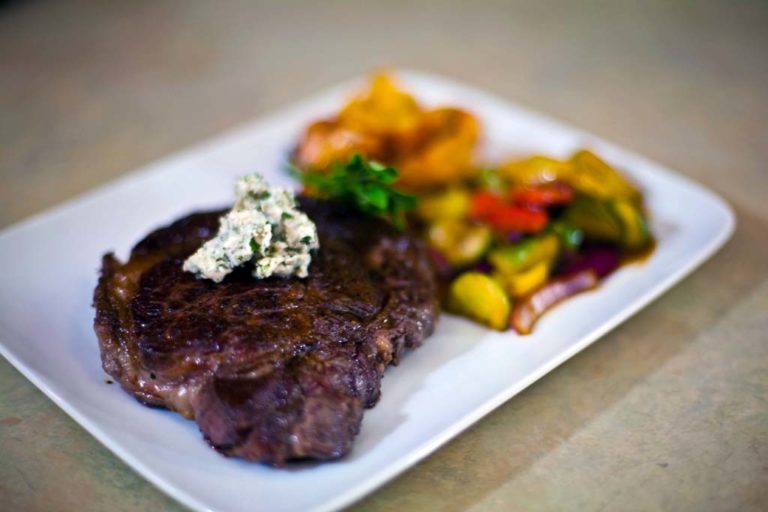
Chef's notes:
Pan frying a steak is sort of a generic search term. This website isn’t necessarily about being vague, but there are certain exceptions. For example, when a vague search phrase is popular enough, that it warrants a little attention from me and How to Cook Meat. Fortunately for you, as you sit here reading this, there are many things that can be said about pan frying steak, simply because the variety of cuts available have so much in common. So, whatever steak you decide to pan fry, this article will help you.
Ingredients
- 2 beef steaks
- Sea salt
- Black pepper
- Vegetable oil
Pan-Fried Beef Steak Served with an Herbed Butter of Fresh Oregano and Rosemary, Sea Salt and Black Pepper
- Select the steak of your choice to pan fry. There are many types of steaks out there, and some of the more choice cuts available include ribeye, strip, sirloin, or tenderloin steaks. Those would all work well for this article, but I chose my favorite: the ribeye. The ribeyes I have here are particularly nice looking. I guess there’s a reason we love corn-fed steak so much, even though it’s bad for us.
- Prepare the steak with sea salt and black pepper for pan frying. First, let the steaks sit on the counter for about 20–30 minutes, so that they warm up to near room temperature. This will help the steaks cook more evenly, inside and out. Season them with whatever you like. I always opt for a little sea salt and black pepper, but it’s entirely up to you. Rub it in, and try to get the sides seasoned well, too.
- Heat up a thick-bottomed skillet over medium high heat. Drizzle a little vegetable oil in the bottom of the pan, just enough to lightly cover it. I wouldn’t recommend using olive oil because it has a low flash point (the temperature at which it combusts) and it will burn both the pan and the meat. Lay the steaks in the bottom of the pan and don’t move them for a couple minutes. Once you start to smell a little smoke, check the bottoms to see how they look.
- Pan fry the steak until it forms a dark crust. The picture on the right is exactly what you want in the look of a steak, not to toot my own horn or anything. The key to forming that crust is to not move them around too much. Be prepared for a little smoke. You will notice that when I flipped these steaks, they were placed onto the unused part of the pan because it is hotter.
- Rest the steak when its done cooking. You will know when the steak is done by the internal temperature. Use a digital thermometer when checking a pan-fried steak. Once the steak is cooked to your preference, remove it to a wire rack, and let the steak rest for 10–15 minutes before serving. The following temperatures (in Fahrenheit) are a good guide depending on your preference. Rare = 120–125, Medium rare = 130–140, Medium = 140–150, Medium well = 150–160, and Well done = 160+
Tips & Tricks
- As strange as it sounds, when buying meat you should ask to smell it. It should smell good, and definitely not sour or rotten. You’ll know when you smell it.
- Let the meat sit on the counter for a little while so that it can warm up to near room temperature. During this stage, I cover mine with plastic wrap to keep it from getting contaminated.
- Season the meat simply with salt and pepper. If you need more flavor, you can top it with the herb butter recipe on the right.
- Pan fry the steak until done, as judged by a digital thermometer.
- If the steak is thick, you may try finishing it in the oven at 350 degrees.
- Always let meat rest after cooking. This will keep it from drying out when cutting into it.
- A little dab of herbed butter on top will go a long way for flavor enhancement. Plus, it just looks nice.
Compound Butter Recipe
- 2–3 Tbsp softened butter
- 1/2 Tbsp chopped oregano
- 1/2 Tbsp chopped rosemary
- 1/2 tsp coarse sea salt
- 1/2 tsp black pepper
Mix all ingredients together very well, and then cool in a refrigerator before mounting on steaks.
